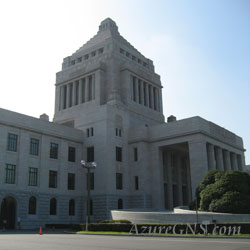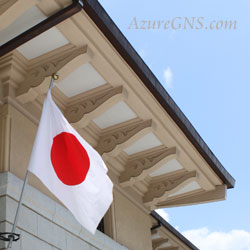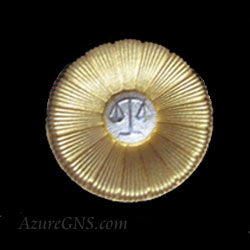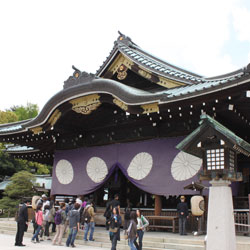国民の祝日
(5月3日)
National Holiday
Kempo-kinenbi
The Constitution Memorial Day
(May 3rd)
●憲法記念日 Kempo-kinenbi; the Constitution Memorial Day;
the Constitution Day
●憲法 constitution; (特定の国の憲法を指す場合は)the Constitution
●日本国憲法 the Constitution of Japan
●大日本帝国憲法 the Constitution of the Japanese Empire;
the Constitution of the Empire of Japan
●憲法を制定する establish the constitution
●憲法を公布する issue the constitution; promulgate the constitution
●憲法を施行する enforce the constitution
●憲法9条 Article 9 of the Constitution; the ninth article of the Constitution
●憲法改正 an amendment to the constitution; a revision of the constitution
●憲法を改正する amend the constitution; revise the constitution
●憲法を擁護する defend the constitution; support the constitution
●憲法違反 unconstitutionality; a breach of the constitution
●三権分立 the separation [division] of the three branches [powers] (of government);
the separation of the government into administrative, legislative and judicial branches
◆1946年(昭和21年)11月3日に現行の日本国憲法が公布されました。
On November 3 of 1946 (Showa 21st yr), the present Constitution of Japan was issued.
◆翌年の1947年(昭和22年)5月3日に施行されました。
On the following year, May 3 of 1947 (Showa 22nd yr), it was enforced.
◆施行を記念して、1948年(昭和23年)に「国民の祝日に関する法律」で5月3日は祝日と定められました。
In commemoration of the enforcement, May 3 was designated as a national holiday in 1948 (Showa 23rd yr), in accordance with “the law for national holidays.”
◆それ以来5月3日は憲法記念日と呼ばれています。
Since then, May 3 has been called Kempo-kinenbi, the Constitution Memorial Day.
◆憲法記念日の趣旨は「日本国憲法の施行を記念し、国の成長を期する」というものです。
The purpose of Kempo-kinebi is “to commemorate the enforcement of the Constitution of Japan, and hope for the growth of the country.”
◆この新しい憲法の骨子は日本の民主主義、基本的人権尊重、三権分立です。
The main points of this new Constitution declare Japan a democracy, proclaim respect for fundamental human rights, and divide the government into three powers.
◆旧憲法である大日本帝国憲法は通称明治憲法と呼ばれています。
The old Constitution, the Constitution of the Japanese Empire, is commonly called the Meiji Constitution.
◆明治憲法は1889年(明治22年)2月11日に発布されました。
On February 11 of 1889 (Meiji 22nd yr), the Meiji Constitution was issued.
◆1890年(明治23年)11月29日に施行されました。
On November 29 of 1890 (Meiji 23rd yr), it was enforced.
◆明治憲法は当時のドイツの憲法を模範に草案が創られた欽定憲法でした。
The Meiji Constitution was the Imperial Constitution and was drafted based on the model of the then existing German constitution.
◆明治憲法では天皇は神聖不可侵で統治権を掌握していました。
In the Meiji Constitution, the Emperor was sacred and inviolable, and had supreme sovereignty.
◆第二次世界大戦で降伏した日本はポツダム宣言により、憲法改正をしなければなりませんでした。
When Japan surrendered in World War ll, it had to revise the Constitution according to the Potsdam Declaration.
◆日本政府側の改正案は旧憲法の骨子を残すものでした。
The amendment made by the Japanese government kept the framework of the old Constitution.
◆このため連合国最高司令官のダグラス・マッカーサーは幕僚に憲法の草案を創らせて、日本政府に公布しました。
Therefore, the Supreme Commander for the Allied Powers, Douglas MacArthur, ordered his staff officers to draft the constitution, and issued it to the Japanese Government.
◆明治憲法は新しい憲法が施行される前日に廃止されました。
The Meiji Constitution was abolished the day before the new Constitution was enforced.
◆現行の憲法では天皇は統治せず、国の象徴となっています。
In the present Constitution, the Emperor doesn’t have any power to rule, but is a symbol of the nation.
◆日本国憲法の中でも第9条が最も重要な特徴で、戦争の放棄をうたっています。
Article 9 of the Japanese Constitution is one of its most important characteristics: it declares the renunciation of war.
◆現在、現行の憲法制定より50年以上が経ちました。
Now, more than 50 years have passed since the Constitution was established.
◆国民や政治の中でさらなる憲法改正、特に第9条について、議論がなされています。
Some citizens and government officials have been discussing further revisions to the Constitution, especially regarding Article 9.
Copyright (C) Azure Global Network Services. All Rights Reserved.







